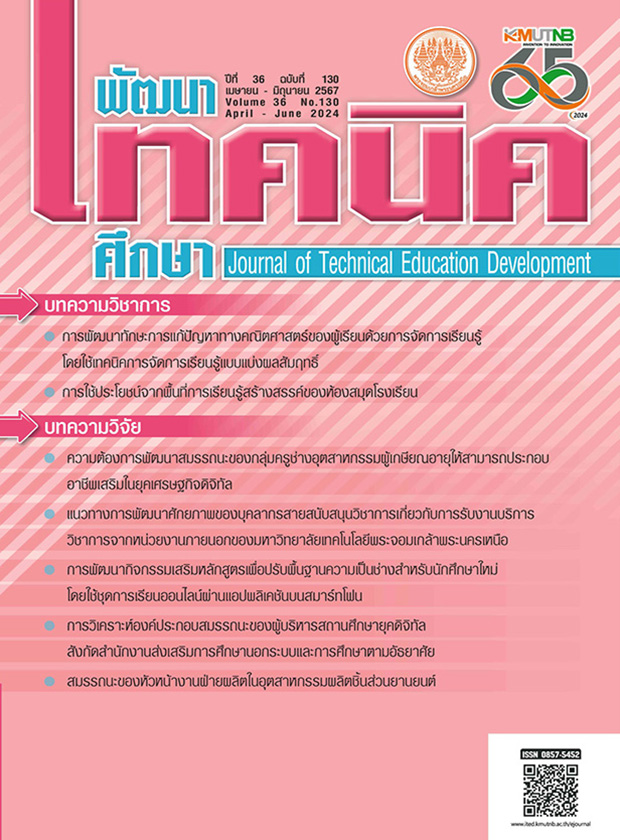การใช้ประโยชน์จากพื้นที่การเรียนรู้สร้างสรรค์ของห้องสมุดโรงเรียน
Main Article Content
บทคัดย่อ
พื้นที่การเรียนรู้สร้างสรรค์ในห้องสมุดโรงเรียนเป็นแหล่งเรียนรู้ที่สามารถบูรณาการเข้ากับหลักสูตรการเรียนการสอนในหลากหลายสาขาวิชา โดยห้องสมุดเป็นศูนย์กลางในการพัฒนาทักษะการเรียนรู้ของผู้เรียน ผ่านการอ่านอันเป็นรากฐานในการเรียนรู้และการพัฒนาทักษะอื่น ๆ เช่น ทักษะการรู้สารสนเทศ ทักษะการรู้เท่าทันสื่อ การคิดวิเคราะห์การแก้ปัญหาและการคิดริเริ่มสร้างสรรค์ โดยธรรมชาติแล้วพื้นที่เรียนรู้สร้างสรรค์แต่ละแห่งมีความแตกต่างกัน ทั้งนี้ขึ้นอยู่กับความพร้อมของห้องสมุด ความต้องการและพฤติกรรมของผู้ใช้ การใช้พื้นที่เรียนรู้สร้างสรรค์ของห้องสมุด สามารถปรับเปลี่ยนพื้นที่เพื่อส่งเสริมการเรียนรู้ที่ใช้งานมากขึ้น การมีส่วนร่วมของนักสารสนเทศที่ช่วยขับเคลื่อนการเรียนรู้ การแลกเปลี่ยนรู้ที่หลากหลาย รวมถึงการใช้อุปกรณ์การสื่อสารที่ทันสมัยจะทำให้ผู้เรียนทุกคนสามารถมีห้องสมุดอยู่ในมือ บทบาทของห้องสมุดกายภาพจึงมีความสำคัญเพิ่มมากขึ้นมิใช่เป็นเพียงสถานที่สำหรับจัดเก็บทรัพยากรสารสนเทศ แต่เป็นพื้นที่สร้างความหมายให้กับข้อมูลแก่ผู้ใช้บริการอย่างมีประสิทธิภาพ
Article Details

อนุญาตภายใต้เงื่อนไข Creative Commons Attribution-NonCommercial-NoDerivatives 4.0 International License.
เอกสารอ้างอิง
นิโลบล วิมลสิทธิชัย. (2562). ห้องสมุดโรงเรียนกับพื้นที่สร้างสรรค์: แหล่งเรียนรู้เพื่อพัฒนาทักษะผู้เรียน ในศตวรรษที่ 21. วารสารห้องสมุด, 63(1), 1-29.
Clark, L. K. (2017). Caregivers’ perceptions of emergent literacy programming in public libraries in relation to the National Research Councils’ guidelines on quality environments for children. Library & Information Science Research, 39, 107–115.
Cun, A., Abramovich, S., & Smith, J. (2019). An assessment matrix for library makerspaces. Library and Information Science Research, 41, 39–47.
Hassinger-Das, B., Zoshb, M., Hansenc, , N., Talarowskid, M. Zmiche, K., Golinkofff, R. M. & Hirsh-Pasekg, K. (2020). Play-and-learn spaces: Leveraging library spaces to promote caregiver and child interaction. Library and Information Science Research, 42, 1-11.
ทัศนีย์ แซ่ลิ้ม. (2560). Learning Commons: พื้นที่เรียนรู้ไร้กำแพง โมเดลห้องสมุดของศตวรรษที่ 21. จาก https://www.tkpark.or.th
Zosh, J. M., Hirsh-Pasek, K., Hopkins, E. J., Jensen, H., Liu, C., Neale, D., ... Whitebread, D. (2018). Accessing the inaccessible: Redefining play as a spectrum. Frontiers in Psychology, 9(1124), 1-11.
Nicholson, S. (2013). Playing in the past: A history of games, toys, and puzzles in north American libraries. The Library Quarterly, 83, 341–361.
Bustamante, A. S., Hassinger-Das, B., Hirsh-Pasek, K., & Golinkoff, R. M. (2019). Putting the science of learning to work: Designing learning landscapes for cities and families. Child Development Perspectives, 13(1), 34–40.
Hassinger-Das, B., Bustamante, A. S., Hirsh-Pasek, K., Golinkoff, R. M., Magsamen, S., Robinson, J. P., & Winthrop, R. (2018). Learning landscapes: Can urban planning and the learning sciences work together to help children? Global Economy and Development Working Paper 124. Washington D.C.: The Brookings Institution.
Weinmann, J. (2014). Makerspaces in the university community. (Master thesis). Institue of Product development, Technische Universität München.
Loertscher, D. V., Preddy, L., & Derry, B. (2013). Makerspaces in the school library learning commons and the uTEC maker model. Teacher librarians, 41(2), 48-51.
Wang, P., Xu, J., & Wu, Y. (2019). Preschool children's preferences for library activities: Laddering interviews in Chinese public libraries. Library & Information Science Research, 41, 132–138.
Hassinger-Das, B., Toub, T. S., Zosh, J. M., Michnick, J., Hirsh-Pasek, K., & Golinkoff, R. M. (2017). More than just fun: A place for games in playful learning (invited). Infanciay Aprendizaje, 40, 191–281.
Laundry Literacy Coalition (2019). Creating literacy-rich spaces in laundromats: Pilot evaluation findings. Retrieved from http://toosmall.org/blog/body/Laundry-LiteracyCoalition-Pilot-Evaluation_Executive-Summary.pdf.


